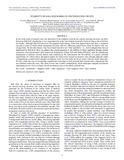Mostrar el registro sencillo del ítem
Stability of hall equilibria in neutron star crusts
| dc.creator | Marchant P. | spa |
| dc.creator | Reisenegger A. | spa |
| dc.creator | Valdivia J.A. | spa |
| dc.creator | Hoyos J.H. | spa |
| dc.date.accessioned | 2015-10-09T13:17:53Z | |
| dc.date.available | 2015-10-09T13:17:53Z | |
| dc.date.created | 2014 | |
| dc.identifier.issn | 0004637X | |
| dc.identifier.uri | http://hdl.handle.net/11407/1374 | |
| dc.description.abstract | In the solid crusts of neutron stars, the advection of the magnetic field by the current-carrying electrons, an effect known as Hall drift, should play a very important role as the ions remain essentially fixed (as long as the solid does not break). Although Hall drift preserves the magnetic field energy, it has been argued that it may drive a turbulent cascade to scales at which Ohmic dissipation becomes effective, allowing a much faster decay in objects with very strong fields. On the other hand, it has been found that there are "Hall equilibria", i.e., field configurations that are unaffected by Hall drift. Here, we address the crucial question of the stability of these equilibria through axially symmetric (2D) numerical simulations of Hall drift and Ohmic diffusion, with the simplifying assumption of uniform electron density and conductivity. We demonstrate the 2D-stability of a purely poloidal equilibrium, for which Ohmic dissipation makes the field evolve towards an attractor state through adjacent stable configurations, around which damped oscillations occur. For this field, the decay scales with the Ohmic timescale. We also study the case of an unstable equilibrium consisting of both poloidal and toroidal field components that are confined within the crust. This field evolves into a stable configuration, which undergoes damped oscillations superimposed on a slow evolution towards an attractor, just as the purely poloidal one. | eng |
| dc.language.iso | eng | |
| dc.publisher | Institute of Physics Publishing | spa |
| dc.relation.isversionof | http://arxiv.org/abs/1410.5833 | spa |
| dc.source | Scopus | spa |
| dc.type | Article | eng |
| dc.rights.accessrights | info:eu-repo/semantics/restrictedAccess | |
| dc.rights.accessrights | info:eu-repo/semantics/restrictedAccess | |
| dc.contributor.affiliation | Instituto de Astrofísica, Facultad de Física, Pontificia Universidad Católica de Chile, Av. Vicuña Mackenna 4860, Macul, Santiago, Chile | spa |
| dc.contributor.affiliation | Argelander-Institut für Astronomie, Universität Bonn, Auf dem Hügel 71, Bonn, Germany | spa |
| dc.contributor.affiliation | Departamento de Física, Facultad de Ciencias, Universidad de Chile, Casilla 653, Santiago, Chile | spa |
| dc.contributor.affiliation | Departamento de Ciencias Básicas, Universidad de Medellín, Cra. 87 # 30-65, Medellín, Colombia | spa |
| dc.identifier.doi | 10.1088/0004-637X/796/2/94 | |
| dc.subject.keyword | instabilities | eng |
| dc.subject.keyword | magnetic fields | eng |
| dc.subject.keyword | stars: magnetars | eng |
| dc.subject.keyword | stars: magnetic field | eng |
| dc.subject.keyword | stars: neutron | eng |
| dc.relation.ispartofen | Astrophysical Journal, 21 octubre de 2014, volume 796, issue 2 | eng |
| dc.title.english | Stability of hall equilibria in neutron star crusts | eng |
| dc.type.driver | info:eu-repo/semantics/article |
Ficheros en el ítem
Este ítem aparece en la(s) siguiente(s) colección(ones)
-
Indexados Scopus [1632]

